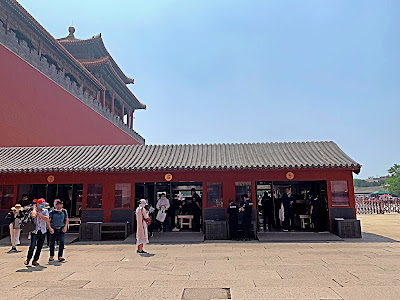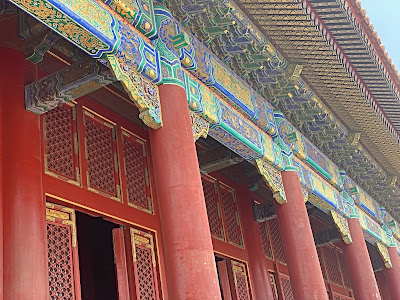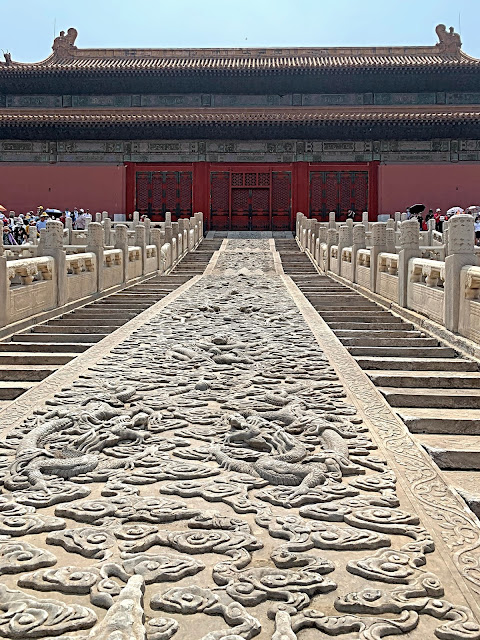Grand entrance into the Forbidden City
Forbidden City
紫禁城 Zǐjìnchéng
This palace complex was built in 1420 by Yonglo, 3rd Emperor of the Ming Dynasty. The Forbidden City was the political and ritual center of China and it was home for 24 emperors, families, and servants during the Ming and Qing Dynasties.
World's largest imperial palace.
This complex comprised of 980 buildings.
World's largest collection of well-preserved medieval wooden structures.
The Forbidden City consists of a ceremonial outer court and a residential inner court.
Forbidden City was named so because the imperial palace was the residence of the emperor and other royalty, therefore, people were forbidden to enter without permission. It was a rigid and solemn place.
90% of the roofs in this 'city' were painted yellow as it was the official and holy color in Chinese architectural history.
Waited for a good 45 mins for this fountain to start 'dancing'!!!
Ming Dynasty columns, 1420
The Meridian Gate
Inner Golden Water Bridge
"Built in the early Ming Dynasty, is a group of 5 single-arched stone bridges in front of the Gate of Supreme Harmony, under which the Inner Golden Water River flows.
The middle bridge is called the Imperial Road Bridge and was exclusively reserved for emperors. The bridge on either sides were used by nobles, ministers, civil and military officials.
Gate of Supreme Harmony 太和门
This gate was originally built during the Ming Dynasty. It was the 2nd major gate in the south of the Forbidden City. It separates the 1st court and the Palace court. Emperors from Ming and Qing Dynasties used this building for banquets and ceremonies.
Palace Museum
National museum housed in the Forbidden City in 1925.
"The Palace Museum was established on the site of the Forbidden City, the imperial palace of the Ming and Qing Synasties. It represents the enduring and resplendent civilisation of China in many way; through its magnificent imperial architecture, through displays of the palace as it was originally furnished, through galleries of Chinese calligraphy and paintings, bronzes, ceramics, jewelry, clocks and other artworks from ancient times, and through special exhibitions."
Hall of Supreme Harmony @Taihedian
It is the grandest building of all in the Forbidden City; standing on a 3-tier marble terrace in the heart of the Forbidden City. Also known as the Golden Carriage Palace, this was where the emperors received high officials and exercised their rule over the nation.
Ancient fire extinguishers!
Taihedian Square
Grain Measure @ Jialiang
"This was a standard grain-measuring device in pre-modern China, using 5 units: hu, dou, sheng, ge and yue. This jialiang was made in 1744. Representing the standardization of weights and measures, the jialiang was placed in front of the palace to symbolize the unification of the empire."
Hall of Central Harmony @ Zhonghedian
This hall served as a place of rest for the emperor.
Hall of Preserving Harmony @ Baohedian
This was where the Ming Emperors would change into their ritual garments prior to ceremonial installations of an empress or crown prince. In the Qing Dynasty, wedding banquets were held here as well.
Palace of Earthly Tranquility @ Kunninggong
The last of the 3 main palaces in the Inner Court of the Forbidden City.
This is where the Empress lived in the Ming Dynasty. After its reconstruction in the Qing Dynasty, it served as the nuptial chamber of the emperor and empress, and the altar for worshipping the deities of Shamanism.
When we visited the Forbidden City, this hall was used to exhibit The Palace Heritage in Stamps!
Imperial Garden @ Yuhuayuan
This was a private retreat for the imperial family and is the most typical Chinese imperial garden design.
The Hall of Imperial Peace @ Qin'andian
The Gate of Divine Prowess @ Shenwumen
In the ancient times, bell and drum were set on the gate tower of Shenwumen to tell the time. The bell would be tolled 108 times after dusk every day and the drum beaten after the bell tolling to tell the end of the day. The bell and drum would repeat at dawn. However, if the emperor was in the palace, there would be silence.
This gate has 3 openings whereby the middle or main gate was for the emperor and empress.
In the Qing Dynasty, there was a selection of concubines every 3 years for the emperor or princes, and some get to become maids in the palace. The candidates used this gate to enter the Forbidden City.
Tongzi Moat
This moat surrounded the Forbidden City during the Ming Dynasty, used as the first defense line for the palace.
Looking across from the exit gate of the Forbidden City is Jingshan Park!
The map of Forbidden City













































































































































No comments:
Post a Comment